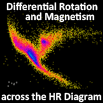Speaker
Liyun Zhang
(University of Oulu)
Description
Solar active longitudes and their rotation have been studied for a long time
using various forms of solar activity. However, the results on the long-term
evolution of rotation rates and the hemispheric asymmetry obtained by earlier
authors differ significantly from each other. We used a dynamic, differentially
rotating reference system to determine the optimum values of the differential
rotation parameters of active longitudes for each year in 1877-2008 and found
a consistent result on the long-term evolution of solar surface rotation in 1877-
2008 separately for the northern and southern hemispheres. Using these
rotation parameters we determined the momentary rotation rates at the
reference latitude of 17° and calculated the non-axisymmetries of active
longitudes. We repeated the procedure using five different fit intervals and two
weighting methods and compared the results. The evolution of solar surface
rotation in each hemisphere suggests a quasi-periodicity of about 80-90 years.
The long-term variations of solar rotation in the northern and southern
hemisphere have a close anti-correlation, leading to a significant 80-90-year
quasi-periodicity in the north-south asymmetry of solar rotation. The north-
south asymmetry of solar rotation is found to have an inverse relationship with
the area of large sunspots. The latitudinal contrast of differential rotation is
also found to be anti-correlated with sunspot area. Different fit and weight
methods yield similar results. Our results give strong evidence for the anti-
correlation of the rotation of the two solar hemispheres. The found long-term
oscillation of solar rotation suggests that a systematic interchange of angular
momentum takes place between the two hemispheres at the period of about
80-90 years.
Author
Liyun Zhang
(University of Oulu)
Co-authors
Ilya Usoskin
(Sodankylä Geophysical Observatory, University of Oulu)
Kalevi Mursula
(University of Oulu)

